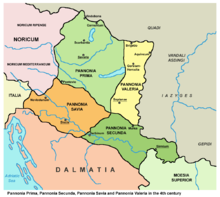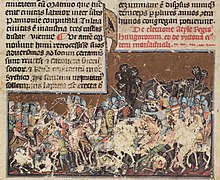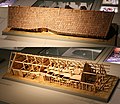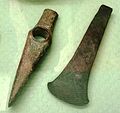History of Hungary before the Hungarian conquest
| History of Hungary |
|---|
 |
|
|
The history of Hungary before the Hungarian conquest spans the time period before the Hungarian conquest in the 9th century of the territories that would become the Principality of Hungary and the Kingdom of Hungary.
The first known traces belong to the
During the Copper and Bronze Ages, three significant groups were the Baden, the Makó and the Ottomány (to not be confused with Ottoman Turks) cultures. The major improvement was obviously metalworking, but the Baden culture also brought about cremation and even long-distance trade with remote areas such as the Baltic or Iran. Turbulent changes during the late Bronze Age gave an end to the native, relatively advanced[4][circular reference] civilization, and the beginning of the Iron Age saw mass immigration of Indo-European nomads believed to be of ancient Iranian ancestry. However, as the time went on, the Carpathian Basin attracted immigration from all directions: the Hallstatt Celts from the west were the first and most influential at around 750 BC, the mysterious Sigynnae around 500 BC, the Pannonians—an Illyrian tribe gave the future Roman province its name, while the very east became occupied by other Thracian, Iranian and later Celtic tribes. Before 100 BC, most of the area was occupied by various Celtic or celticized people, such as the successor of the Halstatt culture, the Taurisci, the Boii and the Pannonians.
The Roman era began with several attacks between 156 and 70 BC, but their gradual conquest was interrupted by the Dacian king Burebista, whose kingdom stretched as far as today's Slovakia at its greatest extent. However, the period of Dacian dominance did not last long, and by 9 BC the Romans had subjugated the entire area and made it into the Pannonia subprovince of province Illyricum and eventually Pannonia province. Under Roman rule, many contemporary cities such as Buda, Győr and Sopron were founded and the population romanized, and culture as a whole flourished. Roman emperors sometimes tolerated other tribes settling in the territory, such as the Iazyges or Vandals. Christianity spread during the 4th century, when it became the state religion.
In the first years of the
Prehistory
Stone Age

The oldest
There is a gap in the archaeological record, with no evidence of human presence between about 250,000 to 100,000 years ago.
Latest research shows that the first communities of
Attracted by the rich fauna of the lowlands in the centre of the Carpathian Basin, groups of "Gravettian" hunters penetrated into the territory from the west about 27,000 years ago.[2] The central grasslands were not covered by ice even at the maximum of the last glaciation (around 20,000 years ago).[2][16] The new arrivals settled on hilltops along the rivers Hornád and Bodrog.[17] They primarily hunted mammoth and elk and used stone blades to work skin, bone, antler and wood.[17] Artistic finds are rare; for instance, a disc with serrated edges, which was made of polished limestone, was found at Bodrogkeresztúr.[17] A second wave of "Gravettians" arrived during the warmer period that began about 20,000 years ago.[18] They primarily made their tools from pebbles, similar to Lower Palaeolithic communities, but no continuity between the two groups can be detected.[18] The remains of semi-sunken huts were excavated at a site on a hilltop near Sárvár where reindeer bones were also found.[18] The site also yielded a perforated (but not decorated) reindeer antler.[18] In addition to permanent settlements, the Gravettian hunters' temporary camps were unearthed in the plains of the Jászság and around Szeged.[18] About 15,000 years ago, new hunters came to the territory; their best-known settlements were situated in northeastern Transdanubia.[18] A pendant made of wolf tooth, a pair of red deer teeth and similar finds suggest that these hunters wore ornaments.[18]
Mesolithic sites are rare but start to appear after systematic surveys, especially in the Jászság area.
Neolithic to Copper Age
Neolithic settlement begins with the Criş-Körös culture, carbon-dated to around 6200 BC. In the Middle Neolithic, the Western Linear Pottery culture in Transdanubia and the Satu-Mare (Szatmar) and Eastern Linear pottery (called "Alföld Linear Pottery" in Hungary) in the east, developed into Želiezovce (Slovakia) and Szakálhát and Bükk, respectively. The Late Neolithic Tisza culture was followed by the Eneolithic Tiszapolgár and Bodrogkeresztúr cultures. These cultures were part of the broader cultural complex known as Old Europe or the Danube civilization.
The
-
Tisza culture ceramic altar, 5300-5200 BC.[19]
-
Anthropomorphic vessel, Linear Pottery culture, c. 5400-4500 BC
-
Neolithic longhouse, Linear Pottery culture, c. 5500-4500 BC
-
Gold idol, Bodrogkeresztúr culture, c. 4000-3600 BC
-
Copper ornaments, Tiszapolgar culture, c. 4000 BC
-
Ceramic vessel, Baden culture, c. 4th millennium BC
-
Modern sculpture of a Baden culture wagon model, c. 3300 BC.[20]
-
Copper axes, Baden culture
Bronze Age
The
-
Bronze dagger, 2000-1800 BC[21]
-
Amber and gold hoard, Hatvan culture, 18th century BC
-
Bronze axe, Ottomány culture, c. 1500 BC
-
Gold armband,Vatya culture, c. 1500 BC
-
Gold jewellery, Encrusted Pottery culture, c. 1500 BC
-
Gold jewellery, Tumulus culture, 15th century BC
-
Bronze bracelet, Tumulus culture
-
Bronze necklace, Tumulus culture
-
Middle Bronze Age burials, museum diorama
-
Various Bronze Age finds
-
Various Bronze Age finds
-
Bronze diadem, Urnfield culture, c. 1200 BC
-
Bronze cauldron, Urnfield culture, c. 1000 BC
-
Bronze situla, Urnfield culture, c. 1000 BC.[24]
-
Large bronze poppy-head pin, Urnfield culture
-
Bronze swords, Urnfield culture, c. 1200 BC
-
Urnfield period warrior, illustration
-
Bronze fitting from a ceremonial wagon, Urnfield culture
-
Various artefacts, Urnfield culture
-
Bronze spiral armbands, Urnfield culture
-
Bronze oil lamp, Urnfield culture[25]
-
Ceramic shoe-shaped vessels, Urnfield culture
-
Százhalombatta-Földvár fortified settlement site
Iron Age

In the Carpathian Basin, the

Around 750 BC, people of the Hallstatt culture gradually occupied the western parts of Transdanubia, but the earlier population of the territory also survived and thus the two archaeological cultures existed together for centuries.[26] The people of the Hallstatt culture took over the former population's fortifications (e.g., in Velem, Celldömölk, Tihany) but they also built new ones enclosed with earthworks (e.g., in Sopron).[26][27] The nobility were buried in chamber tombs covered by earth.[26] Some of their settlements situated along the Amber Road developed into commercial centers.[26][27]
The classic Scythian culture spread across the Great Hungarian Plain between the 7th–6th century BC.[28]
Between 550 and 500 BC, new people settled along the river
The Pannonians (an Illyrian tribe) may have moved to the southern territories of Transdanubia in the course of the 5th century BC.[26]
In the 4th century BC, Celtic tribes immigrated to the territories around the river Rába and defeated the Illyrian people who had been living there, but the Illyrians managed to assimilate the Celts, who adopted their language.[27] In the 290s and 280s BC, the Celtic people who were migrating towards the Balkan Peninsula passed through Transdanubia but some of the tribes settled on the territory.[26] Following 279 BC, the Scordisci (a Celtic tribe), who had been defeated at Delphi, settled at the confluence of the rivers Sava and Danube and they extended their rule over the southern parts of Transdanubia.[26] Around that time, the northern parts of Transdanubia were ruled by the Taurisci (also a Celtic tribe) and by 230 BC, Celtic people (the people of the La Tène culture) had occupied gradually the whole territory of the Great Hungarian Plain.[26] Between 150 and 100 BC, a new Celtic tribe, the Boii moved to the Carpathian Basin and they occupied the northern and northeastern parts of the territory (mainly the territory of present Slovakia).[26]
-
Celtic iron artefacts, La Tène culture
-
Remains of aburial mound, 500 BC
Roman era

The Romans commenced their military raids in the Carpathian Basin in 156 BC when they attacked the Scordisci living in the Transdanubian region.[26][27] In 119 BC, they marched against Siscia (today Sisak in Croatia) and strengthened their rule over the future Illyricum province south of the Carpathian Basin.[26] In 88 BC, the Romans defeated the Scordisci whose rule was driven back to the eastern parts of Syrmia, while the Pannonians moved to the northern parts of Transdanubia.[26][27] When King Mithridates VI of Pontus made plans to attack the Romans by way of the Balkan Peninsula, he referred to the Pannonic tribes, and not to the Scordisci, as masters of the region on his path; it appears, therefore, that around 70–60 BC, the Pannonic tribes were no longer subjugated.[26]
Around 50 BC, the mainly Celtic tribes living on the territory were confronted by Burebista, king of the Dacians (82-44 BC), who began suddenly to expand his domain centered in Transylvania.[29] The sources do not indicate clearly whether Burebista was the original unifier of the Dacian tribes, or whether his efforts at unification built upon the work of his predecessors.[29] Burebista subjugated the Taurisci and the Anarti; in the process, he confronted the Celtic tribal alliance led by the Boii.[27][29] Burebista's victory over the Celts led not only to the breakup of their tribal alliance, but also to the establishment of Dacian settlements in the southern parts of today's Slovakia.[29] Burebista, however, fell victim to his political enemies, and his domain was divided into four parts.[29]
The period between 15 BC and 9 AD was characterized by the continuous uprisings of the Pannonians against the emerging power of the Roman Empire. The Romans, however, could strengthen their supremacy over the rebellious tribes and they organised the occupied territory into a new province.[26]
Pannonia province

The Roman Empire subdued the Pannonians, Dacians, Celts and other peoples in this territory. The territory west of the Danube was conquered by the Roman Empire between 35 and 9 BC, and became a province of the Roman Empire under the name of Pannonia. The easternmost parts of present-day Hungary were later (106 AD) organized as the Roman province of Dacia (lasting until 271). The territory between the Danube and the Tisza was inhabited by the Sarmatian Iazyges between the 1st and 4th centuries AD, or even earlier (earliest remains have been dated to 80 BC). Roman Emperor Trajan officially allowed the Iazyges to settle there as confederates. The remaining territory was in Thracian (Dacian) hands. In addition, the Vandals settled on the upper Tisza in the second half of the 2nd century AD.
Like in the other provinces, in Pannonia, the material culture of the native population showed little sign of Romanization in the first 160 years of Roman rule.[30]
The four centuries of Roman rule created an advanced and flourishing civilization. Many of the important cities of today's Hungary were founded during this period, such as Aquincum (Budapest), Sopianae (Pécs), Arrabona (Győr), Solva (Esztergom), Savaria (Szombathely) and Scarbantia (Sopron). Christianity spread in Pannonia in the 4th century, when it became the empire's official religion.
-
Ruins of Aquincum
-
Ruins of Aquincum
-
Restored section of the Roman aqueduct at Aquincum
-
Aquincum amphitheatre
-
Governors palace of Aquincum
Migration period
Around the same time (379-395), the Roman Empire allowed the groups of Goths, Alans, Huns, Marcomanni and Quadi to settle Pannonia, which still was a Roman territory. The Visigoths, Alans, Vandals and most of the Quadi and Marcomanni, however, left this territory around 400, and moved on to western and southern Europe.
The Pannonian provinces suffered from the Migration Period from 379 onwards, the settlement of the Goth-Alan-Hun ally caused repeated serious crises and devastations, the contemporaries described it as a state of siege, Pannonia became an invasion corridor both in the north and in the south. The flight and emigration of the Romans began after two hard decades in 401, this also caused a recession in secular and ecclesiastical life. The Hun control gradually expanded over Pannonia from 410, finally the Roman Empire ratified the cession of Pannonia by treaty in 433. The flight and emigration of the Romans from Pannonia continued without interruption until the invasion of the Avars. András Mócsy assumes that the largest Roman emigration was the earliest and the 5th and 6th centuries were a phase of gradual emigration.[31]

After the Huns, namely the Hungarians experienced the bravery of the Romans and the way of their warefare, they reorganized their army, rushed the Transdanubian regions of Pannonia, took possession of them and they moved the people of their house here, then they moved towards the city of Tulln, where their opponents were assembled. Detre, Macrinus, and all the available forces of the Roman army marched against them on the field of Zeiselmauer. Both opponents attacked the opposing teams with equal fierceness. And the Huns wanted to die rather than retreat in the battle, according to Scythian custom they made a terrifying noise, they beat their drums and used every weapon against the enemy, but most of all their innumerable number of arrows. This caused the Roman troops to be confused, and so the Huns made a great slaughter among them. The morning began, and in a fierce battle which lasted until nine o'clock, the Roman army was defeated and put to flight with enormous loss.
Bishop Amantius fled around 400 to Aquileia. The emigrating Romans tooks several Christian relics and remains of Pannonian martyrs with them to Rome and to several other towns of Italy. Around 400, the inhabitants of Scarbantia (now Sopron in Hungary) fled from the invasion of the barbarians "incursio barbarorum" to Italy, and took the relics of Quirinus, the martyr bishop of Sescia (now Sisak in Croatia), from Savaria (now Szombathely in Hungary) with them. These events signified the decay of the Christian communities in Pannonia.[31]
The Huns, taking advantage of the departure of the Goths, Quadi, et al., created a significant empire in 423 based in Hungary. In 453 they reached the height of their expansion under the well-known conqueror,
The Gepidi (having lived to the east of the upper Tisza river since 260 AD) then moved into the eastern Carpathian Basin in 455. They ceased to exist in 567 when they were defeated by the
The Germanic Ostrogoths inhabited Pannonia, with Rome's consent, between 456 and 471.
After the Romans


Roman influence in Pannonia had begun to decline as early as the arrival of the Huns in the 4th century.
According to András Mócsy, it is not possible to prove whether the reconstruction of a church is to be attributed to barbarians or to remained Romans at the majority of places. The usage of Christian cult-buildings after the 4th century does not prove the survival of the Pannonian cult-communities because the Goths and other peoples were
Later, Christian barbarians who migrated to the northern part of Lake Balaton established the Keszthely Culture, which disappeared by the middle of the 7th century.[33]
The first Slavs came to the region, almost certainly from the north, soon after the departure of the Ostrogoths (471 AD), together with the Lombards and Herulis. Around 530, the Germanic Lombards settled in Pannonia. They had to fight against the Gepidi and the Slavs. In 568, pushed out by the Avars, they moved into northern Italy.
The nomadic Avars arrived from Asia in the 560s, utterly destroyed the Gepidi in the east, drove away the Lombards in the west, and subjugated the Slavs, partly assimilating them. The Avars established a large empire, just as the Huns had decades prior. This empire was destroyed around 800 by Frankish and Bulgar attacks, and above all by internal feuds, however Avar population remained in numbers until the arrival of Árpád's Magyars. From 800, the whole area of Pannonian Basin was under control between two powers (East Francia and First Bulgarian Empire). Around 800, northeastern Hungary became part of the Slavic Principality of Nitra, which then became part of Great Moravia in 833.
Also, after 800, southeastern Hungary was conquered by
See also
References
- ^ a b c d e Visy 2003, p. 81.
- ^ a b c d e f Visy 2003, p. 84.
- ^ Gimbutas 1991, p. 38.
- ^ Ottomány culture#Collapse and legacy
- ^ Visy 2003, pp. 78–79.
- ^ Kontler 1999, p. 21.
- ^ a b Visy 2003, p. 79.
- ^ a b c d Kovács, Tóth & Bálint 1981, p. 13.
- ^ a b Makkai 1994, p. 21.
- ^ a b Visy 2003, p. 80.
- ^ Cunliffe 1997, p. 25.
- ^ a b c d e Visy 2003, p. 82.
- ^ a b c d Visy 2003, p. 83.
- ^ a b c Adams 2009, p. 433.
- ^ a b Adams 2009, p. 436.
- ^ Cunliffe 1997, p. 43.
- ^ a b c Visy 2003, p. 87.
- ^ a b c d e f g Visy 2003, p. 88.
- ^ "Ritual and Memory: Neolithic Era and Copper Age". Institute for the Study of the Ancient World. 2022.
- ^ Bondar, Maria (2012). "Prehistoric wagon models in the Carpathian Basin, 3500-1500 BC".
- ^ "Bronzkor, p.139" (PDF).
- ^ "Hajdúsámson hoard". Institute for the Study of the Ancient World. 2022.
- ^ "Hajdúsámson sword, Hungary, 1700-1600 BC".
- ^ "Situla". Institute for the Study of the Ancient World. 2022.
- ^ "Bird-shaped lamp, 1200-900 BCE". Institute for the Study of the Ancient World.
- ^ )
- ^ ISBN 963-379-442-0.
- license.
- ^ )
- ISBN 0-88033-479-7.
- ^ ISBN 978-0-415-74582-6.
- ^ Thuróczy, János (1918). A magyarok krónikája [Chronicle of the Hungarians] (in Hungarian). Translated by Horváth, János. Magyar Helikon.
- ^ Straub, Péter (1999). A Keszthely-kultúra kronológiai és etnikai hátterének újabb alternetívája [The chronological and ethnic background of the Keszthely culture, and new alternatives]. Zalai Múzeum.
- ^ Frucht, Richard C., Eastern Europe: An Introduction to the People, Land and Culture ABC-CLIO Ltd (2004) p288
- ISBN 963-482-175-8.
- ISBN 963-482-113-8."2500Ft - Hungarian History in the ninth Century - Hist?riaantik K?nyvesh?z". Archived from the originalon 2011-07-21. Retrieved 2010-10-06.
Sources
- Gimbutas, Marija (1991). The Civilization of the Goddess: The World of Old Europe. Harper San Francisco. ISBN 9780062503688.
- Cunliffe, Barry (Editor) (1997). The Oxford Illustrated History of Prehistoric Europe. Oxford University Press. )
- Adams, Brian (2009). "The Bükk Mountain Szeletian: Old and New Views on "Transitional" Material from the Eponymous Site of the Szeletian". In Camps, Marta; Chauhan, Parth R. (eds.). Sourcebook of Paleolithic Transitions. Springer. pp. 427–440. ISBN 978-0-387-76487-0.
- Kontler, László (1999). Millennium in Central Europe: A History of Hungary. Atlantisz Publishing House. ISBN 963-9165-37-9.
- Kovács, Tibor; Tóth, István; Bálint, Csanád (1981). "Magyarország a honfoglalás előtt [Hungary before the Hungarian Conquest]". In Solymosi, László (ed.). Magyarország történeti kronológiája, I: a kezdetektől 1526-ig [Historical Chronology of Hungary, Volume I: From the Beginning to 1526] (in Hungarian). Akadémiai Kiadó. pp. 13–52. ISBN 963-05-2661-1.
- Makkai, László (1994). "Hungary before the Hungarian conquest". In Sugar, Peter F.; Hanák, Péter; Frank, Tibor (eds.). A History of Hungary. Indiana University Press. pp. 1–7. ISBN 963-7081-01-1.
- Molnár, Miklós (2001). A Concise History of Hungary. Cambridge University Press. ISBN 978-0-521-66736-4.
- Visy, Zsolt (Editor-in-Chief) (2003). Hungarian Archaeology at the Turn of the Millennium. Ministry of National Cultural Heritage, Teleki László Foundation. )
External links
 Media related to History of Hungary before the Hungarian conquest at Wikimedia Commons
Media related to History of Hungary before the Hungarian conquest at Wikimedia Commons

![Tisza culture ceramic altar, 5300-5200 BC.[19]](http://upload.wikimedia.org/wikipedia/commons/thumb/e/e0/Tisza1.jpg/120px-Tisza1.jpg)





![Modern sculpture of a Baden culture wagon model, c. 3300 BC.[20]](http://upload.wikimedia.org/wikipedia/commons/thumb/3/3a/Baden_wagon_1.jpg/120px-Baden_wagon_1.jpg)

![Bronze dagger, 2000-1800 BC[21]](http://upload.wikimedia.org/wikipedia/commons/thumb/7/76/Bronzedagger.png/109px-Bronzedagger.png)

![Hajdúsámson-type sword, Ottomány culture, 1700-1600 BC.[22][23]](http://upload.wikimedia.org/wikipedia/commons/thumb/9/93/Hajd%C3%BAs%C3%A1mson_type_sword.jpg/60px-Hajd%C3%BAs%C3%A1mson_type_sword.jpg)











![Bronze situla, Urnfield culture, c. 1000 BC.[24]](http://upload.wikimedia.org/wikipedia/commons/thumb/4/4e/Urnfield2.jpg/109px-Urnfield2.jpg)






![Bronze oil lamp, Urnfield culture[25]](http://upload.wikimedia.org/wikipedia/commons/thumb/f/f1/Bronze_vessel%2C_Hungary%2C_Bronze_Age%2C_Urnfield_culture.png/120px-Bronze_vessel%2C_Hungary%2C_Bronze_Age%2C_Urnfield_culture.png)








